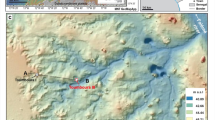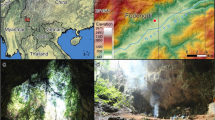Abstract
This paper discusses the late Pleistocene lithic sequence at Klipfonteinrand (KFR) rockshelter in the eastern Cederberg of the Western Cape. A characteristically Robberg technological system associated with the production of small silcrete blades from small cores was in place at the site by ~ 22 ka (thousand years ago) with a hornfels-dominant, non-microlithic Oakhurst system replacing it ~ 16 ka. Key technological differences in lithic material selection, artifact size, form, and techniques relating to the manufacturing process itself are apparent between early and later components within the Robberg, and between the Robberg and Oakhurst more broadly. Results suggest that technological change during the late Pleistocene was a fluid process involving continual modifications within the broad regional technological system. Variation during the Robberg occurred within a constrained range and the nature of change through the sequence was overall relatively gradual. The KFR data contributes to the emerging picture of the Robberg as temporally, spatially, and technologically complex with nuanced variation at a very fine scale of analysis.
Résumé
Cet article caractérise la séquence lithique du pléistocène supérieur provenant du Klipfonteinrand Rockshelter (KFR) situé dans la région du Cederberg oriental (Cap-Occidental). Le système technologique de Robberg est. ici associé à la production de petites lames de silcrète faites à partir de petits noyaux qui étaient sur le site il y a environ 22 ka (il y a mille ans). Ce système est. par la suite remplacé par celui d’Oakhurst étant non microlitique à dominante cornéenne à une date relativement précoce ~16 ka. Les principales différences technologiques dans la sélection des matériaux lithiques, la taille ou la forme des artéfacts et des techniques relatives au processus de fabrication sont apparentes entre les composantes précoces et postérieures du système de Robberg et, plus généralement, entre Robberg et Oakhurst. Les résultats suggèrent que le changement technologique vers la fin du pléistocène était un processus fluide impliquant des modifications continuelles au sein d’un plus large système technologique étant en place à ce moment-là. Durant le système de Robberg, la variation s'est produite et a été contrainte par la nature du changement effectuer à travers la séquence qui était dans l'ensemble relativement graduelle. Les données de KFR contribuent à l'image émergente du système de Robberg se définissant comme complexe temporellement, spatialement et technologiquement avec une variation nuancée relative à la nature du changement technologique apparente sur une échelle plus réduite.








Similar content being viewed by others
References
Barham, L. S. (1987). The bipolar technique in southern Africa: A replication experiment. South African Archaeological Bulletin, 42(145), 45–50.
Bousman, C. B., & Brink, J. S. (2018). The emergence, spread, and termination of the Early Later Stone Age event in South Africa and southern Namibia. Quaternary International, 495, 116–135.
Bronk Ramsey, C. (2009). Bayesian analysis of radiocarbon dates. Radiocarbon, 51(01), 337–360.
Deacon, H. J. (1976). Where hunters gathered: A study of Holocene Stone Age people in the eastern Cape. Claremont, South Africa: South African Archaeological Society.
Deacon, J. (1978). Changing patterns in the Late Pleistocene/Early Holocene prehistory of southern Africa as seen from the Nelson Bay Cave stone artifact sequence. Quaternary Research, 10(1), 84–111.
Deacon, J. (1984). The Later Stone Age of southernmost Africa, Oxford:British Archaeological Reports (BAR) International Series 213.
De la Peña, P. (2015). A qualitative guide to recognize bipolar knapping for flint and quartz. Lithic Technology, 40(4), 316–331.
Dibble, H. L. (1997). Platform variability and flake morphology: A comparison of experimental and archaeological data and implications for interpreting prehistoric lithic technological strategies. Lithic Technology, 22(2), 150–170.
Hogg, A. G., Hua, Q., Blackwell, P. G., Niu, M., Buck, C. E., Guilderson, T. P., Heaton, T. J., Palmer, J. G., Reimer, P. J., Reimer, R. W., Turney, C. S. M., & Zimmerman, S. R. H. (2013). SHCal13 Southern Hemisphere calibration, 0-50,000 years cal BP. Radiocarbon, 55(4), 1889–1903.
Kaplan, J. (1990). The Umhlatuzana rock shelter sequence: 100 000 years of Stone Age history. Natal Museum Journal of Humanities, 2, 1–94.
Lin, S. C., Rezek, Z., Braun, D., & Dibble, H. L. (2013). On the utility and economization of unretouched flakes: The effects of exterior platform angle and platform depth. American Antiquity, 78(4), 724–745.
Loftus, E., Sealy, J., & Lee-Thorp, J. (2016). New radiocarbon dates and Bayesian models for Nelson Bay Cave and Byneskranskop 1: Implications for the South African later stone age sequence. Radiocarbon, 58(2), 365–381.
Lombard, M., Wadley, L., Deacon, J., Wurz, S., Parsons, I., Mohapi, M., Swart, J., & Mitchell, P. (2012). South African and Lesotho Stone Age sequence updated. South African Archaeological Bulletin, 67(195), 123–144.
Low, M. & Mackay, A. In review. The organisation of Late Pleistocene Robberg blade technology in the Doring River catchment, South Africa.
Low, M. A., & Mackay, A. (2016). The late Pleistocene microlithic at Putslaagte 8 Rockshelter in the Western Cape, South Africa. South African Archaeological Bulletin, 71(204), 146–159.
Low, M., Mackay, A., & Phillips, N. (2017). Understanding Early Later Stone Age technology at a landscape-scale: Evidence from the open-air locality Uitspankraal 7 (UPK7) in the Western Cape, South Africa. Azania: Archaeological Research in Africa, 52(3), 373–406.
Mackay, A. (2009). History and selection in the late Pleistocene archaeology of the Western Cape, South Africa. PhD dissertation, The Australian National University.
Mackay, A. (2012). Report on excavations at Klipfonteinrand, 2011/12, V2. Australian National University, Canberra.
Mackay, A., Caroline, C. C., Heinrich, S., Low, M. A., Stahlschmidt, M. & Steele, T. E. (in prep.). Excavations at Klipfonteinrand reveal varying scales of population interaction through MIS 2 in southern Africa.
Mackay, A., Jacobs, Z., & Steele, T. E. (2015). Pleistocene archaeology and chronology of Putslaagte 8 (PL8) Rockshelter, Western Cape, South Africa. Journal of African Archaeology, 13(1), 71–98.
Mackay, A., Stewart, B. A., & Chase, B. M. (2014). Coalescence and fragmentation in the late Pleistocene archaeology of southernmost Africa. Journal of Human Evolution, 72, 26–51.
Mitchell, P. J. (1988). The early microlithic assemblages of southern Africa. Oxford: BAR International Series.
Mitchell, P. J. (1995). Revisiting the Robberg: New results and a revision of old ideas at Sehonghong Rock Shelter, Lesotho. The South African Archaeological Bulletin, 50(161), 28–38.
Mitchell, P. J. (2002). The archaeology of southern Africa. Cambridge: Cambridge University Press.
Muller, A., & Clarkson, C. (2014). Estimating original flake mass on blades using 3D platform area: Problems and prospects. Journal of Archaeological Science, 52, 31–38.
Odell, G. H. (2003). Lithic analysis, New York, Springer.
Orton, J. (2006). The Later Stone Age lithic sequence at Elands Bay, Western Cape, South Africa: Raw materials, artefacts and sporadic change. Southern African Humanities, 18(2), 1–28.
Orton, J. (2014). SALSA: The Holocene technocomplexes, a reply to Lombard and colleagues. South African Archaeological Bulletin, 69(199), 110–112.
Pargeter, J., Loftus, E., Mackay, A., Mitchell, P., & Stewart, B. (2018). New ages from Boomplaas Cave, South Africa, provide increased resolution on late/terminal Pleistocene human behavioural variability. Azania: Archaeological Research in Africa, 53(2), 156–184.
Pargeter, J., Loftus, E., & Mitchell, P. (2017). New ages from Sehonghong rock shelter: Implications for the late Pleistocene occupation of highland Lesotho. Journal of Archaeological Science: Reports, 12, 307–315.
Pargeter, J., & Redondo, M. (2016). Contextual approaches to studying unretouched bladelets: A late Pleistocene case study at Sehonghong Rockshelter, Lesotho. Quaternary International, 404(Part B), 30–43.
Parkington, J. (1977). Follow the San. Cambridge: Cambridge University Press.
Parkington, J. & Yates, R. (n.d.). The stone tool assemblages. In J. Parkington (Ed.), Elands Bay cave: A view on the past. Unpublished manuscript.
Pelcin, A. (1997). The effect of indenter type on flake attributes: Evidence from a controlled experiment. Journal of Archaeological Science, 24(7), 613–621.
Porraz, G., Igreja, M., Schmidt, P., & Parkington, J. E. (2016). A shape to the microlithic Robberg from Elands Bay Cave (South Africa). Southern African Humanities, 29, 203–247.
RStudio Team. (2016). RStudio: Integrated Development for R. Boston, MA: RStudio, Inc.
Schweitzer, F. R. & Wilson, M. L. (1982). Byneskranskop 1 A late Quaternary living site in the southern Cape Province, South Africa. Cape Town: The Rustica Press.
Soriano, S., Villa, P., & Wadley, L. (2007). Blade technology and tool forms in the Middle Stone Age of South Africa: The Howiesons Poort and post-Howiesons Poort at Rose Cottage Cave. Journal of Archaeological Science, 34(5), 681–703.
Wadley, L. (1993). The Pleistocene Later Stone Age South of the Limpopo River. Journal of World Prehistory, 7(3), 243–296.
Wadley, L. (1996). The Robberg Industry of Rose Cottage Cave, eastern Free State: The technology, spatial patterns and environment. The South African Archaeological Bulletin, 55(171), 64–74.
Wickham, H. (2016). ggplot2: Elegant graphics for data analysis. New York: Springer-Verlag.
Acknowledgements
Funding for research at Klipfonteinrand comes from the Australian Research Council grant DP#1092445 or DE130100068 awarded to Alex Mackay. My research has been conducted with the additional support of the Australian Government Research Training Program Scholarship and by grants from the Centre for Archaeological Science and the University of Wollongong. Thank you to Alex Mackay and Sam Lin for comments on the earlier drafts. Thanks particularly to Sam Lin for his guidance and patience in providing advice and assistance with the statistical analyses performed in this study. Thanks to Shane Hourigan for producing the locational figure and to Mélissa Verrier for translating the abstract into French. Thanks also to the Archaeology department at the University of Cape Town for providing lab space.
Author information
Authors and Affiliations
Corresponding author
Ethics declarations
Conflict of Interest
The author declares no conflict of interest.
Additional information
Publisher’s Note
Springer Nature remains neutral with regard to jurisdictional claims in published maps and institutional affiliations.
Rights and permissions
About this article
Cite this article
Low, M. Continuity, Variability and the Nature of Technological Change During the Late Pleistocene at Klipfonteinrand Rockshelter in the Western Cape, South Africa. Afr Archaeol Rev 36, 67–88 (2019). https://doi.org/10.1007/s10437-018-9318-y
Published:
Issue Date:
DOI: https://doi.org/10.1007/s10437-018-9318-y




